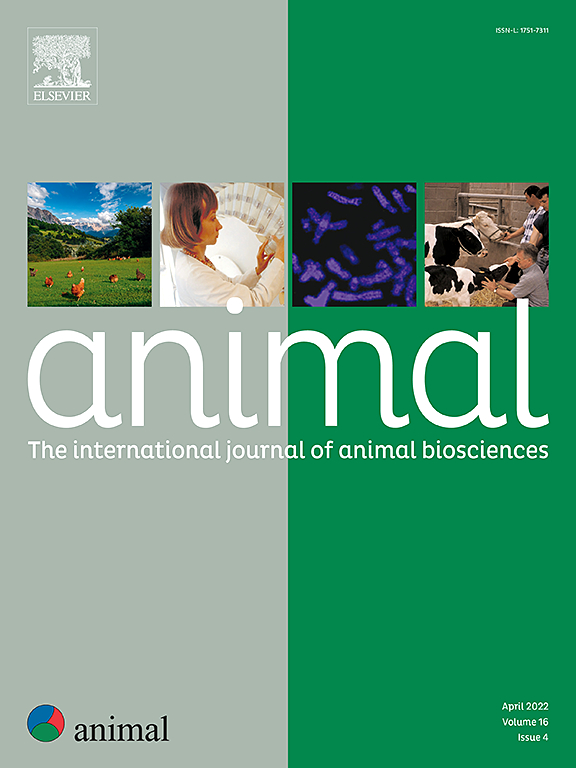A conceptual mechanistic model of amino acid fluxes in the small intestine, taking the example of pig
IF 4
2区 农林科学
Q1 AGRICULTURE, DAIRY & ANIMAL SCIENCE
引用次数: 0
Abstract
During digestion, almost 50% of absorbed essential amino acids (AAs) are metabolised by intestinal tissue, thus not appearing directly in the portal vein. This value, which is referred to as first-pass metabolism, seems high in relation to the overall efficiency of AA use considered in growth models. Experimental studies of first-pass metabolism are complicated due to the presence of numerous metabolic fluxes in the intestine and to the dynamics of digestion and absorption. The aim of this study was to integrate current knowledge of the metabolic AA fluxes in the small intestine in a conceptual model of intestinal AA metabolism. The model was built as a series of 200 intestinal segments, each having the same structure. Each segment was composed of seven pools, representing the fate of a generic AA according to their location (i.e., luminal or intestinal), origin (i.e., dietary or endogenous), and form (i.e., as protein or as a free AA). The pools were connected by fluxes, representing the main fates of AA, such as saturable transport of luminal AA or homeostasis of free or protein-bound AA in intestinal tissue. To parameterise the model, data from the literature were used, as well as values considered as reasonable. Simulations were carried out over 24 h, with five meals during the day and fasting during the night. Representing the small intestine as a series of segments allowed to account both for its tubular structure and for changing luminal environment. During the day, the model simulated the uptake of AA from the intestine and export to the blood, while during the night it simulated the uptake of AA from the blood to ensure intestinal homeostasis. Approximately, half of dietary AAs absorbed were metabolised in first-pass by intestinal tissue (i.e., used for intestinal protein synthesis). Part of this intestinal protein was secreted in the lumen as endogenous protein, which was driven by the presence of digesta, and endogenous protein can be digested and absorbed in more distal segments. In vivo, only the apparent first-pass metabolism of AA can be measured due to the dynamics of AA recycling and the tubular structure of the small intestine. This model can be a valuable tool for research and education to simulate the impact of nutrition on intestinal AA metabolism.
以猪为例的小肠氨基酸通量的概念机制模型。
在消化过程中,几乎50%被吸收的必需氨基酸(AAs)被肠组织代谢,因此不会直接出现在门静脉中。这个值被称为首过代谢,似乎与生长模型中考虑的AA利用的总体效率有关。由于肠道内存在大量代谢通量以及消化和吸收的动力学,首过代谢的实验研究非常复杂。本研究的目的是将小肠代谢AA通量的现有知识整合到肠道AA代谢的概念模型中。该模型由200个肠段组成,每个肠段具有相同的结构。每个片段由7个池组成,根据它们的位置(即肠内或肠内)、来源(即膳食或内源性)和形式(即作为蛋白质或作为游离AA)代表一个通用AA的命运。这些池通过通量连接,代表了AA的主要命运,如腔内AA的饱和运输或肠道组织中游离或蛋白结合的AA的稳态。为了参数化模型,使用了文献中的数据以及被认为合理的值。模拟在24小时内进行,白天五餐,晚上禁食。将小肠表示为一系列的节段,以解释其管状结构和不断变化的管腔环境。在白天,该模型模拟AA从肠道摄取并输出到血液中,而在夜间,它模拟AA从血液中摄取,以确保肠道内稳态。大约一半的日粮吸收的AAs在第一次通过肠道组织代谢(即用于肠道蛋白质合成)。部分肠道蛋白作为内源性蛋白在管腔内分泌,受食糜存在的驱动,内源性蛋白可以在更远的节段被消化吸收。在体内,由于AA循环的动力学和小肠的管状结构,只能测量AA的表观首过代谢。该模型可为模拟营养对肠道AA代谢的影响提供有价值的研究和教育工具。
本文章由计算机程序翻译,如有差异,请以英文原文为准。
求助全文
约1分钟内获得全文
求助全文
来源期刊

Animal
农林科学-奶制品与动物科学
CiteScore
7.50
自引率
2.80%
发文量
246
审稿时长
3 months
期刊介绍:
Editorial board
animal attracts the best research in animal biology and animal systems from across the spectrum of the agricultural, biomedical, and environmental sciences. It is the central element in an exciting collaboration between the British Society of Animal Science (BSAS), Institut National de la Recherche Agronomique (INRA) and the European Federation of Animal Science (EAAP) and represents a merging of three scientific journals: Animal Science; Animal Research; Reproduction, Nutrition, Development. animal publishes original cutting-edge research, ''hot'' topics and horizon-scanning reviews on animal-related aspects of the life sciences at the molecular, cellular, organ, whole animal and production system levels. The main subject areas include: breeding and genetics; nutrition; physiology and functional biology of systems; behaviour, health and welfare; farming systems, environmental impact and climate change; product quality, human health and well-being. Animal models and papers dealing with the integration of research between these topics and their impact on the environment and people are particularly welcome.
 求助内容:
求助内容: 应助结果提醒方式:
应助结果提醒方式:


